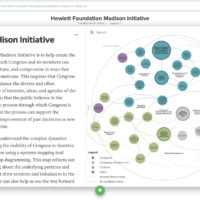
Kumu
Kumu is a powerful data visualization platform that helps you organize complex information into interactive relationship maps.

Kumu is a powerful data visualization platform that helps you organize complex information into interactive relationship maps.
Connect the Dots, a project of DataBasic.io, show you how your data is connected by analyzing it as a network.
Easily create a beautiful, interactive, powerful network visualization from either an uploaded dataset or from scratch using Onodo’s web interface. No coding skills required.
A graph visualization application for the web.
(VIS) is a data visualization platform designed to assist investigative journalists, activists and others in mapping complex business or crime networks. Our aim is to help investigators understand and explain corruption, organized crime and other wrongdoings and to translate complex narratives into simple, universal visual language. VIS provides professionally designed, customizable, dynamic html5 visualization templates allowing you to illustrate entities, networks and complex configurations of data. Visualizations can be exported for use in online, print or broadcast media. n Examples/References: Gallery
Free and open-source software for social network analysis. (Submitted by Annelies Kamran)
Grano is an open source tool for journalists and researchers who want to track networks of political or economic interest. It helps understand the most relevant relationships in your investigations, and to merge data from different sources.
Neo4j is a highly scalable native graph database that leverages data relationships as first-class entities, helping enterprises build intelligent applications to meet today’s evolving data challenges.
With Textexture you can visualize any text as a network. The resulting graph can be used to get a quick visual summary of the text, read the most relevant excerpts (by clicking on the nodes), and find similar texts. n Examples/reference: Example
QueryTree lets you explore your data yourself with it’s easy to use drag and drop tools for exploring, analysing and visualizing data. There’s no code or formulas to write and it runs in your browser so there’s no software to install.
Sigma is a JavaScript library dedicated to graph drawing. It makes easy to publish networks on Web pages, and allows developers to integrate network exploration in rich Web applications.
Gephi is an open-source, free interactive visualisation and exploration platform for all kinds of networks and complex systems, dynamic and hierarchical graphs. It claims to be “like Photoshop but for data”, allowing the user to interact with the data representation, manipulate structures, shapes and colours to reveal hidden properties.
Graphviz is open source graph visualization software. Graph visualization is a way of representing structural information as diagrams of abstract graphs and networks. It has important applications in networking, bioinformatics, software engineering, database and web design, machine learning, and in visual interfaces for other technical domains. n Examples/references: Gallery
Cytoscape is an open source software platform for visualizing complex networks and integrating these with any type of attribute data. A lot of Apps are available for various kinds of problem domains, including bioinformatics, social network analysis, and semantic web.
CodeFlower is an experiment that visualizes source repositories using an interactive tree. Each disc represents a file, with a radius proportional to the number of lines of code (loc). All rendering is done client-side, in JavaScript. It is built with d3.js and inspired by Code Swarm and Gource. n Examples/references: Example projects
A library of force-directed layout algorithms plus abstractions for graph organization and refresh handling.
A software package for visualizing data in a circular layout.